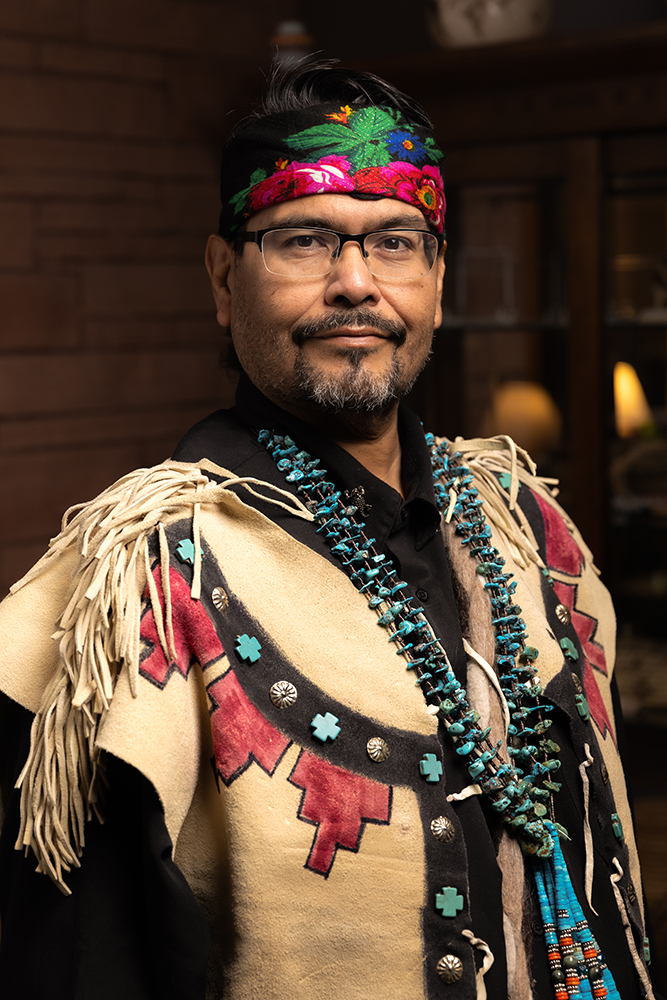In August, a third elder joined NAU’s Elder Cultural Advisors program with the support of donors David and Marianne Gates and others. Albert Chase, who is Diné, does fabric arts, wool work, weaving, basket-making, beading, traditional outfit- and moccasin-making, traditional dance and more, as well as working in education to help ensure the preservation of the Diné language and culture. In his cultural consulting work, he works with companies and organizations to provide culturally competent education and consulting. Hear more from Chase and learn more about the elder cultural advisors program.
My Clans are:
- Honághaanii nishłį́, One Who Walks Around in today’s translation, but according to my grandmother, Honághanii nishłį́, is from the shoulder people, as stories tell we were made from shoulder of Changing Woman.
- México Dine’é báshíshchíín, People of Mexico, or people of the south. (Possibly the Aztecan people)
- Txóbąąhí dashicheii, Edge Water are my maternal grandfathers.
- Naatxoohí Diné’é dashinálí – Isleta Pueblo are my paternal grandfathers.
My original place of home is where my hoghan nímazí exists.
The place where my young mind developed and recognized as my first home and first language is called Dibénjígą́ą́h-Big Horn Sheep Mountain or Łį̨́į́’ Hádét’į̨įh- Looking Horse. That is my original place and land that I come from. This is where I recognize sitting on dirt floors and eating with family, my elders and great-grandparents. This place is where I experienced the soft and warm beddings of sheep hide and the warmth of woven blankets. This place is where I heard the crackling of our fire pit in the center of our dwelling and saw the cloud of smoke rising to the sky through the smoke hole. This place is where I can hear grandmother carding her wool and spinning her wool while waiting for the coffee and food to finish. This place is where I could hear grandfather releasing the sheep for the day and hear the morning greetings of the flock and the ringing of their bell necklaces. This special place is embedded in me and is the driving sentimental force and blessings, which must be shared with our coming generations.
I started school at 8 or 9 years old with the boarding school system at Dilcon, Arizona, then was signed up for the Indian Placement Program sponsored by the Mormon church (7th-12th grade). I went to Vernal Junior High and High School (Uintah High School) in Utah, then did summer session schooling at Brigham Young University in Provo Utah. I attended there for 2.5 years then decided to come home to Arizona—I had a strong feeling to move home to care for my grandmother, who adopted me as well as my mother who both became widows, as well as a passion to regain K’éhasin and reconnect with my Diné language and culture.
I attended Northland Community College class and took a Navajo language class to learn how to read and write in Diné, then began to follow and trust in the promptings of the Holy Ones and relied a lot on my prayers and faith that I will have a good and meaningful path to follow. My personal passion and life experiences became my guide in seasoning my focus in teaching language and culture. Life (iiná) became the beacon of light as my reconnection with home, family, teaching, our wonderful Diné students, co-workers, administrators and communities. Our philosophical teachings of Natsáhákees, Nahat’áh, Iiná and Siihasin became the natural foundation and focus to my work as Diné Pollen Trail Cultural Consulting.
What is the Elders Cultural Advisors program? Run through the Native American Cultural Center, this program is essential to NAU’s mission of serving Native American students. The elders offer cultural continuity, traditional knowledge teachings, mentoring and spiritual support to NAU’s students. Learn more about the program.
Who are the Elder Cultural Advisors? In addition to Chase, Viki Blackgoat (Diné) and LeRoy Shingoitewa (Hopi) are elders this academic year. Their positions are all funded by private gifts and grants. Previous elders include Paul Long, Sr. (Diné), Lorenzo Max (Diné) and Marina Vasquez (Mayan). Read more about what elders do to support students at NAU.



